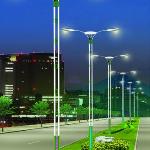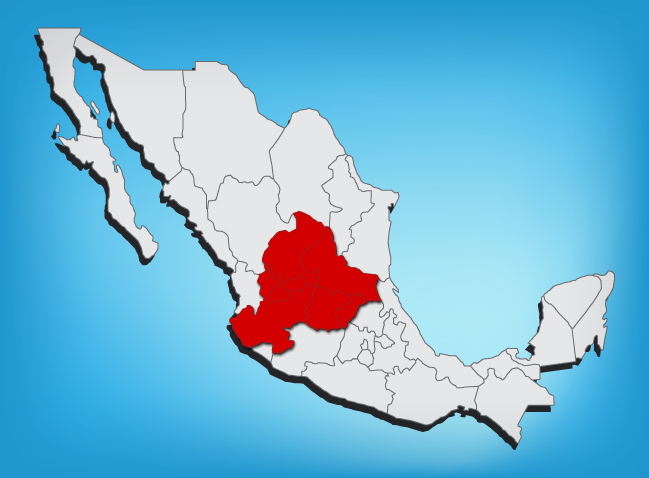
Smart LED Streetlamps system through the implementation of mesh networks by hector_bracamontes
Pitch
Streetlamps are part of the city’s street furniture. Their Electricity consumption represents a high percentage of a small-size city budget.
Description
Summary
It is proposed to explore the feasibility of switching actual streetlamps technology to LED and implementing a mesh network to control them in small-size cities in Mexico.
The output will be an assessment which will serve as technology roadmap and the pilot test implementation of the streetlamp control in a small-size city with installed LED streetlamps. The system might be replicated for other cities within the country.
The carbon emission reductions from the LED streetlamps could be until 60% versus the business as usual scenario. Additionally, the control system implementation might reach until 40% energy savings compared to the scenario with only LED fixtures. Therefore, the LED streetlamps with a control system would save until 80% of energy consumption.
Category of the action
Building efficiency, Social Action
What actions do you propose?
Streetlamps are part of the city’s street furniture, which are utilized primarily for keeping pedestrians security and for preventing car accidents on roads.
Electricity consumed from streetlamps represents a high percentage of a small-size city[1] budget [ii]; Additionally, streetlamps have the hightest electricity tariff in Mexico (0.20 USD/Kwh)[ix][x]. Furthermore, local governments do not have enough staff for managing the streetlamps malfunctioning.
By the other side, big cities (more than 1 million inhabitants) have implemented LED (Light-emitting Diode)streetlamps, in the recent years, to reduce their energy consumption and two of them have implemented tele-management control in the northern states of Mexico (Monterrey and Chihuahua).[xi]
Wireless Mesh networks are composed of radio frequency nodes serving as relays, as well as capturing and disseminating its own data, and forming a distributed communication network. Even if one of the communication connections go down, the transmission between the nodes still work. It means that in case of a natural disaster like hurricanes or strong storms, the communication will not collapse (An example is a mesh network in New York did not collapse during hurricane Katrina). [vi][vii]
In the present text, it is proposed to carry out an assessment for switching actual streetlamps technology to LED streetlamps with control system and to implement a pilot wireless mesh network for controlling them in a small-size city.[iv]
The assessment will be a technology roadmap, which could be replicated to other small-size cities and will serve for recommending criteria and user options when appropriate, for minimizing errors and omissions by reviewing a checklist and finally, it should be under continual revision to be improved.

Fig 1. Wireless Mesh Network. Source: Greenbang 2013
[1] For the purpose of the present proposal, we will call a small-size city, the one with less than 120,000 inhabitants.
Who will take these actions?
A start-up or project developer will be able to manage the project, look for technology and financial partners, engage the local governments or the contractor company for streetlamps maintenance and interact with all the stakeholders, in order to implement a pilot control system in a small-size city.

Fig 2. Adaptive lighting system. Source: Cunningham, 2013 [xiii]
Where will these actions be taken?
Recently, the Federal Government of Mexico has published their National Strategy on Climate Change, where it is stablished a legal framework to promote energy efficiency in different sectors including municipalities. For this reason, Mexico is an appropriate country to implement energy efficiency projects. [xii]
Small-size cities located either in the states of Guanajuato, Querétaro, Jalisco, Zacatecas, Aguascalientes or San Luis Potosi in Mexico.
These states are selected because:
They are exposed to strong storms or hurricanes; therefore, the mesh network is suitable for keeping streetlamps control in case of a natural disaster and also it allows other communication services to work.
They have high potential growth because of important foreign investment.

Fig 3. States where the project could be implemented. Source: AIMhttp://mercadotecnia-aim.com/cobertura.html
How much will emissions be reduced or sequestered vs. business as usual levels?
Up to 60% of carbon emissions reduction can be reached for switching the streetlamps technology to LED. (See the example of the city of Boston http://www.cityofboston.gov/publicworks/lighting/led.asp)
Adding the control package, 40% of additional energy demand reduction might be attained compared to a static installation of the same equipment. [xiii]
For example, in United Kingdom (UK) by implementing the control system, 100 kg of CO2 per streetlamp were reduded[viii] (This amount might be variable depending on the country's grid emission factor).
The carbon emission reductions from the implementation of the mesh network control system shall be measurable, reportable and verifiable. Therefore, the software will monitor [xviii]:
- Date of streetlamp substitution.
- Serial number of each streetlamp.
- Type of streetlamp.
- Nominal Power (Watts).
- On / Off schedule.
- Annual Operating hours.
- Outage Factor.
- Annual Failure Rate.
What are other key benefits?
- Higher energy efficiency. LED streetlamps will reduce the energy demand from the municipality.
- Lower streetlamps maintenance cost (parts, truck runs). [xiv] The tele-management system through the mesh network will allow the government staff to know when and where the malfunctioning streetlamp is occurring.
- Improve efficiency by detering wire theft and batch repairs. [xiv]
- Technology transfer. If the project is implemented, it will reduce the technology gap between the big and small-size cities.
- More available resources for the municipality to invest on adapting policies. By reducing the energy consumption cost, the city will have more resources available for other issues, including adapting policies.
Fig 4. Streetlamp with control equipment. Source: Harvard Engineering Plc [viii]
What are the proposal’s costs?
Assumptions:
For making the assessment, an engineer will be needed 280 hours (7 weeks, 5-day weeks, 8 hrs/day) at a rate of 15 USD/hr [xvii] = 4,200 USD
For implementing the pilot mesh network control system, 30 streetlamps will be statistically reliable and representative [xv] for a municipality with 1,000 streetlamps and 90% / 10% confidence /precision.
Prices for streetlamp controllers are between 70 – 300 USD/streetlamp [xvi]; for the present text it will be assumed the midrange value of 185 USD/streetlamp and 8 USD/streetlamp for the installation
The pilot mesh network control system will control 30 streetlamps at 185 USD. Therefore it will cost 5,550 USD. Additionally, the installation it will cost 240 USD.
Resume
Once analyzed, it is roughly estimed that the controllers would have a payback period of 0.5 - 2 years and a lifetime of 7 - 10 years. [v]
Time line
The project activities will have the following time line:
Source: own elaboration
*MoU: Memorandum of Understanding
Related proposals
References
[i] SENER. Guía iluminación eficiente en alumbrado público. http://www.conuee.gob.mx/work/sites/CONAE/resources/LocalContent/7369/8/alumbrado_publico.pdf
[ii] Moreno Ramiro. Cuesta caro arreglar alumbrado público. 2013. http://www.am.com.mx/sanfrancisco/local/cuesta-caro-arreglar-alumbrado-publico--19402.html
[iii] SENER (Ministery of Energy). Proyecto Nacional de Eficiencia Energética en alumbrado público municipal .http://www.conuee.gob.mx/wb/CONAE/alumbrado_publico
[iv] PRNewsWire. Smart Street Lighting http://www.prnewswire.com/news-releases/smart-street-lighting-174238441.html
[v] Wikipedia. Street light controller.http://en.wikipedia.org/wiki/Street_light_controller
[vi] Nicta. Wireless Mesh Network for Public Safety and Crisis Management. http://www.nicta.com.au/__data/assets/pdf_file/0015/15621/Wireless_Mesh_Networks_for_Public_Safety_and_Crisis_Management_Applications.pdf
[vii] Computer Hope http://www.computerhope.com/jargon/m/mesh.htm
[viii] Hardvard Engineering Plc - Blackpool brings street lighting control into the 21st century. June 2010. http://www.dpaonthenet.net/article/34745/Blackpool-brings-street-lighting-control-into-the-21st-century.aspx
[ix] CFE tariff for street lamps in June 2013 (http://app.cfe.gob.mx/Aplicaciones/CCFE/Tarifas/Tarifas/Tarifas_industria.asp?Tarifa=5A&Anio=2013&mes=6)
[x] Exchange rate 12.85 MXN/USD on 06/06/2013 by Bloomberghttp://www.bloomberg.com/quote/USDMXN
[xi] El Porvenir. Presentan sistema de telegestión para alambrado público de Monterrey. Nov 2011http://www.youtube.com/watch?v=hErtZhkyrf8
[xii] Federal Government of Mexico. National Strategy on Climate Change. June 2013 http://www.dof.gob.mx/nota_detalle.php?codigo=5301093&fecha=03/06/2013
[xiii] Cunningham, Kelly. June 11, 2013.Adaptive Street Lighting Controls Part I: Experiences and Benefits [Webinar ]. http://apps1.eere.energy.gov/buildings/publications/pdfs/ssl/msslc_controls-webcast-pt1_06-11-13.pdf
[xiv] Stuchinsky, Laura. June 12, 2013. Adaptive Street Lighting Controls Part II: Reviewing the MSSLC's Model Specification [Webinar]. http://apps1.eere.energy.gov/buildings/publications/pdfs/ssl/msslc_controls-webcast-pt2_06-12-13.pdf
[xv] UNFCCC. Standard for sampling and surveys for CDM project activities and programme of activities. 2012 http://cdm.unfccc.int/Reference/Standards/meth/meth_stan05.pdf
[xvi] Pacific Gas and Electric Company. Street Lighting Network Controls Market Assessment Report. January 2010. http://www.etcc-ca.com/images/pge0914.pdf
[xvii] Engineer Salaries in Mexico, June 2013. http://www.misalario.org/main/tu-salario/comparatusalario
[xviii] UNFCCC. AMS-II.L. - Demand-side activities for efficient outdoor and street lighting technologies. http://cdm.unfccc.int/methodologies/DB/V53UISEM035E08WWY2S5M3IHUEJYTU